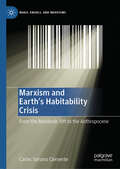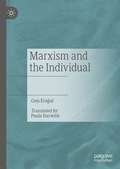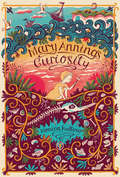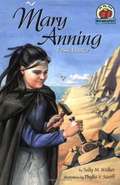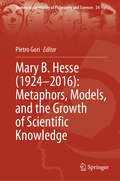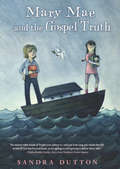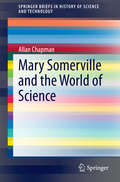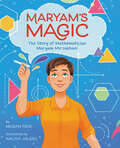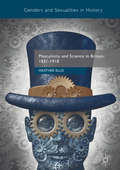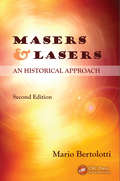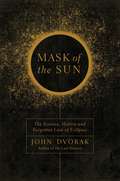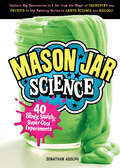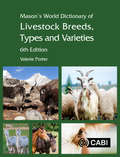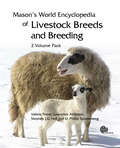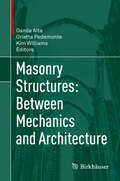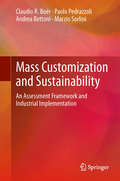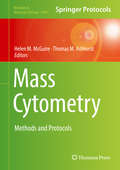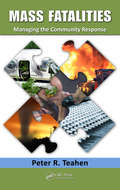- Table View
- List View
Marxism and Earth's Habitability Crisis: From the Metabolic Rift to the Anthropocene (Marx, Engels, and Marxisms)
by Carles Soriano ClementeThis book argues that as long as capitalism is globally dominant, there must be a crisis of habitability on Earth. Overcoming this crisis is not a matter of technology. Technological strategies need to be adopted to mitigate human impact on Earth, but as long as they are implemented on a capitalist basis the crisis will not be overcome. Unfortunately, this is not fully understood today, and initiatives to confront the crisis based on idealism and positivism flourish everywhere. This makes research into the main epistemological reasons for the misunderstanding of the relationship between the reproduction of capital and the crisis of habitability an urgent task, which is undertaken throughout the book. Such misunderstanding is ultimately related to the old problem of philosophy, the relationship between thought and being. A problem that the crisis of habitability expresses as the insurmountable contradiction between capitalist humans and nature.
Marxism and the Individual
by Cem EroğulThis book attempts to develop a Marxist theory of the human individual. It contends that the standard description of the human as a bio-psycho-social being is fundamentally deficient as it doesn’t specify which of these attributes is the determining one. As long as this is not done, the real nature of humanity cannot be uncovered.
Marxism in the Age of Ecological Catastrophe: Theory and Praxis (Marx and Marxisms)
by Eduardo Sá BarretoMarxism in the Age of Ecological Catastrophe offers a stimulating discussion on the ecological unfeasibility of capitalist society.Divided into three parts, Eduardo Sá Barreto begins by providing a reconstruction of Marx’s theory of value and articulating it into a ecological critique of this society. Part Two surveys key debates between some of today's most representative Marxist ecologists. Part Three explores political approaches, tactical and strategic issues to see whether they align with the gravity of the challenges facing humanity or not.Located at the intersection of the natural and social sciences, Marxism in the Age of Ecological Catastrophe will be of interest to scholars of political science, economics, ecology, climatology, demography, geography, and sociology.
Mary Anning and Paleontology for Kids: Her Life and Discoveries, with 21 Activities (For Kids series)
by Stephanie BearceMary Anning was only 12 years old when she excavated the skeleton of an unknown animal. The discovery of the ichthyosaur was the dawn of a new age of science called paleontology, and Anning became one of the leading experts in the study of dinosaurs. Her discoveries helped lay the groundwork for Charles Darwin's theory of evolution and changed the way scientists understood the past. Unfortunately, as a woman of the 1800s, Anning received almost no recognition for her contributions, which were instead credited to the male naturalists who had purchased her specimens. Author Stephanie Bearce brings Anning's remarkable work to life for young readers with research and projects that allow children to experience hands‑on science as Anning did.Kids will create fossil models in plaster and use tools to extract them, build a Mesozoic diorama of a dinosaur habitat, grow crystals in an eggshell to observe how geodes are formed, and much more!
Mary Anning and the Sea Dragon
by Jeannine AtkinsThe girl who found the first sea reptile fossil Mary Anning loved to scour the shores of Lyme Regis, England, where she was born in 1799, for stone sea lilies and shells. Her father had taught her how to use the tools with which she dug into the sand and scraped at the stones that fell from the cliffs. And he had taught her how to look, to look hard, for "curiosities. " One day, when she was eleven, Mary Anning spotted some markings on a wide, flat stone. She chipped at it with her hammer and chisel until the lines of a tooth emerged--and then those of another tooth. Weeks of persistent effort yielded a face about four feet long. But what creature was this? Her brother called it a sea dragon. Many months later, Mary Anning still had not unearthed what she only then learned was called a fossil. But she found out that her discovery was precious and that the painstaking effort to uncover traces of ancient life was profoundly important.
Mary Anning's Curiosity
by Monica KullingThe amazing story of how the world’s greatest fossilist found her first huge find at the age of twelve.Mary was born in 1799 in Lyme Regis, England, to a poor family. She and her older brother were the only two of ten children to survive. Her father, a carpenter and part-time fossil hunter, taught his children to look for fossils.When her father injured himself and was unable to work, Mary quit school and took up fossil hunting full-time to help support her family, a task that became even more important when her father died, leaving the Annings in debt. At the age of twelve, Mary, with her older brother Joe, found what they believed to be the skeleton of a gigantic crocodile, the Great Croc of the legends. Between dodging her rival fossil hunter, the Curiman, and the sheer work of carefully digging out the fossil, Mary took almost a year to excavate what would later be termed the Ichthyosaurus. Mary Anning may have been uneducated, poor and a woman, but her life’s work of fossil hunting led her to make many discoveries that influenced our understanding of prehistoric creatures and the age of the Earth. In 2010, Mary was named among the ten British women who have most influenced the history of science. Charles Darwin even cited Mary’s fossilized creatures as evidence in his book On the Origin of Species. In this triumphant novel about scientific discovery, Monica Kulling brings Mary Anning and her world to life for young readers. Key Text Featuresauthor's notehistorical contextresourcesfactsfurther reading
Mary Anning: Fossil Hunter
by Sally M. WalkerDescribes the life of Mary Anning, who discovered many of the best and most complete fossils in nineteenth-century England, yet received little credit for her work.
Mary Anning: The Girl Who Cracked Open The World
by Debora PearsonAs a young girl, Mary Anning loved to hunt for fossils by the sea. She wondered whether these rock creatures had ever been alive and resolved to learn all she could about what she found. As her discoveries became larger and more unusual, she earned the respect of scientists far and wide and changed the way we study Earth's history forever.
Mary B. Hesse (Women in the History of Philosophy and Sciences #24)
by Pietro GoriThis volume explores the work of Mary B. Hesse (1924–2016), a pivotal figure in twentieth-century philosophy of science. At a time when the foundations of an integrated approach to the history and philosophy of science were being established, Hesse, as a female philosopher, offered a distinctive and influential contribution grounded in a post-empiricist understanding of the natural sciences. Central to her thought was a focus on the metaphorical and analogical value of scientific language, in contrast to views assessing its literal significance. Hesse also departed from traditional hypothetico-deductive accounts of scientific methodology and theory structure, advancing instead perspectives rooted in both historical and contemporary scientific practices. To mark the centenary of her birth, this book brings together an international group of scholars to re-examine and engage with Hesse&’s intellectual legacy. The chapters address the central themes of her work and situate them within her broader philosophical context. Each contribution adopts a cross-disciplinary perspective, highlighting the continued relevance of Hesse&’s ideas to current debates in the philosophy of science.This volume will be of particular interest to scholars in the history and philosophy of science, as well as those engaged in gender studies and the study of women in philosophy.
Mary Mae and the Gospel Truth
by Sandra DuttonTen-year-old Mary Mae loves to sing hymns with her Granny, go to Sunday School, and learn about trilobites. She has lots of questions about how the earth looked millions of years ago. Trouble is, Mary Mae's mother thinks it's wrong to believe the world is that old. Mama believes God created it six thousand years ago and she believes that nobody should teach Mary Mae otherwise. When Mary Mae starts taking her questions to church, asking how God created the earth in six days or how eight people could take care of animals on an ark, Mama puts her foot down: homeschooling. Mary Mae must decide where her loyalties lie: with science and Miss Sizemore, with God and Mama, or somewhere in the middle.
Mary Somerville and the World of Science
by Allan ChapmanMary Somerville (1780-1872), after whom Somerville College Oxford was named, was the first woman scientist to win an international reputation entirely in her own right, rather than through association with a scientific brother or father. She was active in astronomy, one of the most demanding areas of science of the day, and flourished in the unique British tradition of Grand Amateurs, who paid their own way and were not affiliated with any academic institution. Mary Somerville was to science what Jane Austen was to literature and Frances Trollope to travel writing. Allan Chapman's vivid account brings to light the story of an exceptional woman, whose achievements in a field dominated by men deserve to be very widely known.
Maryam's Magic: The Story of Mathematician Maryam Mirzakhani
by Megan ReidFrom Althea Gibson author Megan Reid and rising star artist Aaliya Jaleel, illustrator of Under My Hijab, comes the first picture book about trailblazing mathematician Maryam Mirzakhani, the first woman to win the world’s most prestigious honor in mathematics. Perfect for fans of Hidden Figures and Mae Among the Stars. As a little girl, Maryam Mirzakhani was spellbound by stories. She loved reading in Tehran’s crowded bookstores, and at home she'd spend hours crafting her own tales on giant rolls of paper. Maryam loved school, especially her classes in reading and writing. But she did not like math. Numbers were nowhere near as interesting as the bold, adventurous characters she found in books. Until Maryam unexpectedly discovered a new genre of storytelling: In geometry, numbers became shapes, each with its own fascinating personality—making every equation a brilliant story waiting to be told. As an adult, Maryam became a professor, inventing new formulas to solve some of math's most complicated puzzles. And she made history by becoming the first woman—and the first Iranian—to win the Fields Medal, mathematics’ highest award. Maryam's Magic is the true story of a girl whose creativity and love of stories helped her—and the world—to see math in a new and inspiring way.
Maryland Science: A Closer Look
by Macmillan Mcgraw HillThe contents of Maryland Science A Closer Look include: Living Organisms, Ecosystems, Our Dynamic Earth, Earth's Resources, The Universe, Matter, Motion and Energy.
Masculinity and Science in Britain, 1831–1918
by Heather EllisThis book offers the first in-depth study of the masculine self-fashioning of scientific practitioners in nineteenth and early twentieth-century Britain. Focusing on the British Association for the Advancement of Science, founded in 1831, it explores the complex and dynamic shifts in the public image of the British 'man of science' and questions the status of the natural scientist as a modern masculine hero. Until now, science has been examined by cultural historians primarily for evidence about the ways in which scientific discourses have shaped prevailing notions about women and supported the growth of oppressive patriarchal structures. This volume, by contrast, offers the first in-depth study of the importance of ideals of masculinity in the construction of the male scientist and British scientific culture in the nineteenth and early twentieth centuries. From the eighteenth-century identification of the natural philosopher with the reclusive scholar, to early nineteenth-century attempts to reinvent the scientist as a fashionable gentleman, to his subsequent reimagining as the epitome of Victorian moral earnestness and meritocracy, Heather Ellis analyzes the complex and changing public image of the British 'man of science'.
Masers and Lasers: An Historical Approach
by Mario BertolottiMasers and Lasers: An Historical Approach examines the progress of research and practical use of lasers chronologically, covering the fundamental science in detail alongside fascinating biographical sketches of famous physicists and summaries of seminal papers. It supplies helpful drawings of prototype devices, conceptual diagrams to aid in underst
Mask of the Sun: The Science, History And Forgotten Lore Of Eclipses
by John DvorakThey have been thought of as harbingers of evil as well as a sign of the divine. Eclipses—one of the rarest and most stunning celestial events we can witness here on Earth—have shaped the course of human history and thought since humans first turned their eyes to the sky. What do Virginia Woolf, the rotation of hurricanes, Babylonian kings and Einstein’s General Theory Relativity all have in common? Eclipses. Always spectacular and, today, precisely predicable, eclipses have allowed us to know when the first Olympic games were played and, long before the first space probe, that the Moon was covered by dust. Eclipses have stunned, frightened, emboldened and mesmerized people for thousands of years. They were recorded on ancient turtle shells discovered in the Wastes of Yin in China, on clay tablets from Mesopotamia and on the Mayan “Dresden Codex." They are mentioned in Homer’s Iliad and Odyssey and at least eight times in the Bible. Columbus used them to trick people, while Renaissance painter Taddeo Gaddi was blinded by one. Sorcery was banished within the Catholic Church after astrologers used an eclipse to predict a pope’s death. In Mask of the Sun, acclaimed writer John Dvorak the importance of the number 177 and why the ancient Romans thought it was bad to have sexual intercourse during an eclipse (whereas other cultures thought it would be good luck). Even today, pregnant women in Mexico wear safety pins on their underwear during an eclipse. Eclipses are an amazing phenomena—unique to Earth—that have provided the key to much of what we now know and understand about the sun, our moon, gravity, and the workings of the universe. Both entertaining and authoritative, Mask of the Sun reveals the humanism behind the science of both lunar and solar eclipses. With insightful detail and vividly accessible prose, Dvorak provides explanations as to how and why eclipses occur—as well as insight into the forthcoming eclipse of 2017 that will be visible across North America.
Mason Jar Science: 40 Slimy, Squishy, Super-Cool Experiments; Capture Big Discoveries in a Jar, from the Magic of Chemistry and Physics to the Amazing Worlds of Earth Science and Biology
by Jonathan AdolphHeatproof, transparent, and durable, the mason jar is a science lab just waiting to be discovered. Unlock its potential with 40 dynamic experiments for budding scientists ages 8 and up. Using just a jar and a few ordinary household items, children learn to create miniature clouds, tiny tornadoes, small stalactites, and, of course, great goo and super slime! With a little ingenuity, the jar can be converted into a lava lamp, a water prism, a balloon barometer, and a compass. Each fun-packed project offers small-scale ways to illustrate the big-picture principles of chemistry, botany, biology, physics, and more. This publication conforms to the EPUB Accessibility specification at WCAG 2.0 Level AA.
Mason's World Dictionary of Livestock Breeds, Types and Varieties
by Valerie PorterMason's World Dictionary of Livestock Breeds, Types and Varieties, now in its sixth edition, has a long history as a reliable and authoritative source of key livestock breed information. Intended as a list of livestock names and synonyms for breeds, groups, types and varieties worldwide, the dictionary aims to include all names found in the literature, 'defining' each breed or type with a brief indication of identifying characteristics, uses and source of origin. Expanded into a new edition, this established and trusted resource: Extends coverage to include yak and camelids in addition to the existing cattle, sheep, pigs, goats, horses, asses and water buffalo.Features well over 10,000 entries and cross-references on breeds, sub-breeds, types, varieties, strains and lines of species.Covers newly created and now-recognised local breeds documented over the past two decades. An important updated work, Mason's Dictionary forms a useful reference for livestock breeders and academics interested in breeds, as well as national and international organizations with interests in livestock.
Mason's World Encyclopedia of Livestock Breeds and Breeding: 2 volume pack
by Valerie Porter D. Phillip Sponenberg Stephen Hall Lawrence AldersonMason's World Encyclopedia of Livestock Breeds and Breeding describes breeds of livestock worldwide as well as a range of breed-related subjects such as husbandry, health and behaviour. This definitive and prestigious reference work presents easily accessible information on domestication (including wild ancestors and related species), genetics and breeding, livestock produce and markets, as well as breed conservation and the cultural and social aspects of livestock farming. Written by renowned livestock authorities, these volumes draw on the authors' lifelong interest and involvement in livestock breeds of the world, presenting a unique, comprehensive and fully cross-referenced guide to cattle, buffalo, horses, pigs, sheep, asses, goats, camelids, yak and other domesticants. Volume 1: contains asses, camelids, cattle, goats, horses and pigs Volume 2: contains sheep, water buffalo, yak and other livestock Coverage: Breed descriptions: including groups, types and varieties, history and links between groups, livestock products and trends for creating new breeds Wild species: ancestral and relatives, potential domesticants and hybridization Humans and breeds: spread of domestication, transhumance and pastoralism, social and cultural influences, suitability of different groups for different human purposes Genetics and Conservation: a dedicated section and glossary of terms Placing breeds in a practical agricultural context, this two volume encyclopedia will be of great value to agriculturalists, breeders, geneticists, biologists, rural historians, conservationists, ecologists, and all those who are interested in the rich diversity of livestock breeds.
Masonry Structures: Between Mechanics and Architecture
by Kim Williams Danila Aita Orietta PedemonteThe book aims to provide an overview of the state of the art on the mechanics of arches and masonry structures. It is addressed to an international audience, arising from the international context in which the Associazione Edoardo Benvenuto has carried out its activities in recent years, under the honorary presidency of Jacques Heyman. The book belongs to the collection Between Mechanics and Architecture, born in 1995 from the collaboration of several renowned scholars, including Edoardo Benvenuto (P. Radelet-de Grave, E. Benvenuto (eds. ), Entre Mécanique et Architecture / Between Mechanics and Architecture, Birkhäuser, Basel 1995).
Maspin
by Mary J.C. HendrixThis book represents the first compilation of the major research findings regarding Maspin a mammary serpin (or serine) protease inhibitor. Maspin was originally discovered through subtractive hybridization and differential display analyses, comparing the differences in gene expression in normal mammary epithelium and invasive carcinoma cells. This work originated in the laboratory of Dr. Ruth Sager, a world-renowned geneticist, at the Dana Farber Cancer Institute and Harvard Medical School. The first introduction of Maspin to the research community occurred as a report in Science (v263:526-529, 1994), and described the unique tumor-suppressing activity of this novel gene in human mammary epithelial cells.
Masquerade: Amazing Deception and Camouflage Strategies of World War II
by Seymour ReitSeymour Reit's quiet wit and riveting style walks the reader through multiple types of deception and camouflage used by both Allied and Axis powers during World War II.
Mass Customization and Sustainability
by Andrea Bettoni Marzio Sorlini Paolo Pedrazzoli Claudio R. BoërTo adapt to global competitive pressures, manufacturers must develop methods and enabling technologies towards a personalized, customer oriented and sustainable manufacturing. Mass Customization and Sustainability defines the two concepts of mass customization and sustainability and introduces a framework to establish a link between the two concepts to answer the questions: Are these two aspects empowering one another? Or are they hindering one another? These questions investigate mass customization as one of the main driving forces to achieve effective sustainability. A methodology to assess the contribution of mass customization to sustainability is developed, providing an assessment model composed by a set of indicators covering the three aspects of sustainability: social, economical and environmental. This is supported and further explained using ideas and new concepts compiled from recent European research. Researchers, scientists, managers and industry professionals alike can follow a set of practical examples and industrial cases, enabling them to easily transfer Mass Customization and Sustainability theoretical concepts into actions to be enforced into their everyday business for gaining competitiveness. Mass Customization and Sustainability also introduces useful concepts for government officials responsible for establishing sustainable policies and regulations, offering methods to compare the results of implementation of such policies.
Mass Cytometry: Methods and Protocols (Methods in Molecular Biology #1989)
by Helen M. McGuire Thomas M. AshhurstThis book details up-to-date and cutting edge compilation of protocols in mass cytometry. Chapters guide readers through setting up a facility, panel design and reagent preparation, sample preparation, specific applications, and data analysis. Written in the highly successful Methods in Molecular Biology series format, chapters include introductions to their respective topics, lists of the necessary materials and reagents, step-by-step, readily reproducible laboratory protocols, and tips on troubleshooting and avoiding known pitfalls.Authoritative and cutting-edge, Mass Cytometry: Methods and Protocols aims to ensure successful results in the further study of this vital field.
Mass Fatalities: Managing the Community Response
by Peter R. TeahenA mass fatalities response goes far beyond returning the remains of a loved one to surviving family members. Those charged with this grim but critical responsibility will find themselves immersed in multiple tasks involving diverse individuals, organizations, and priorities. Mass Fatalities: Managing the Community Response examines multiple complex
